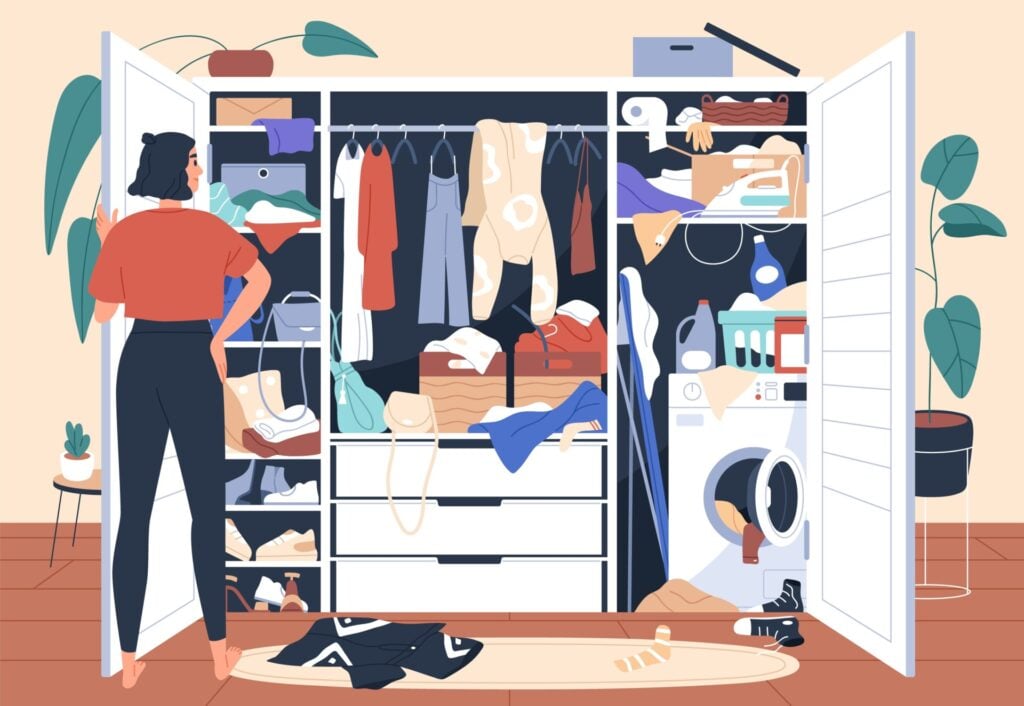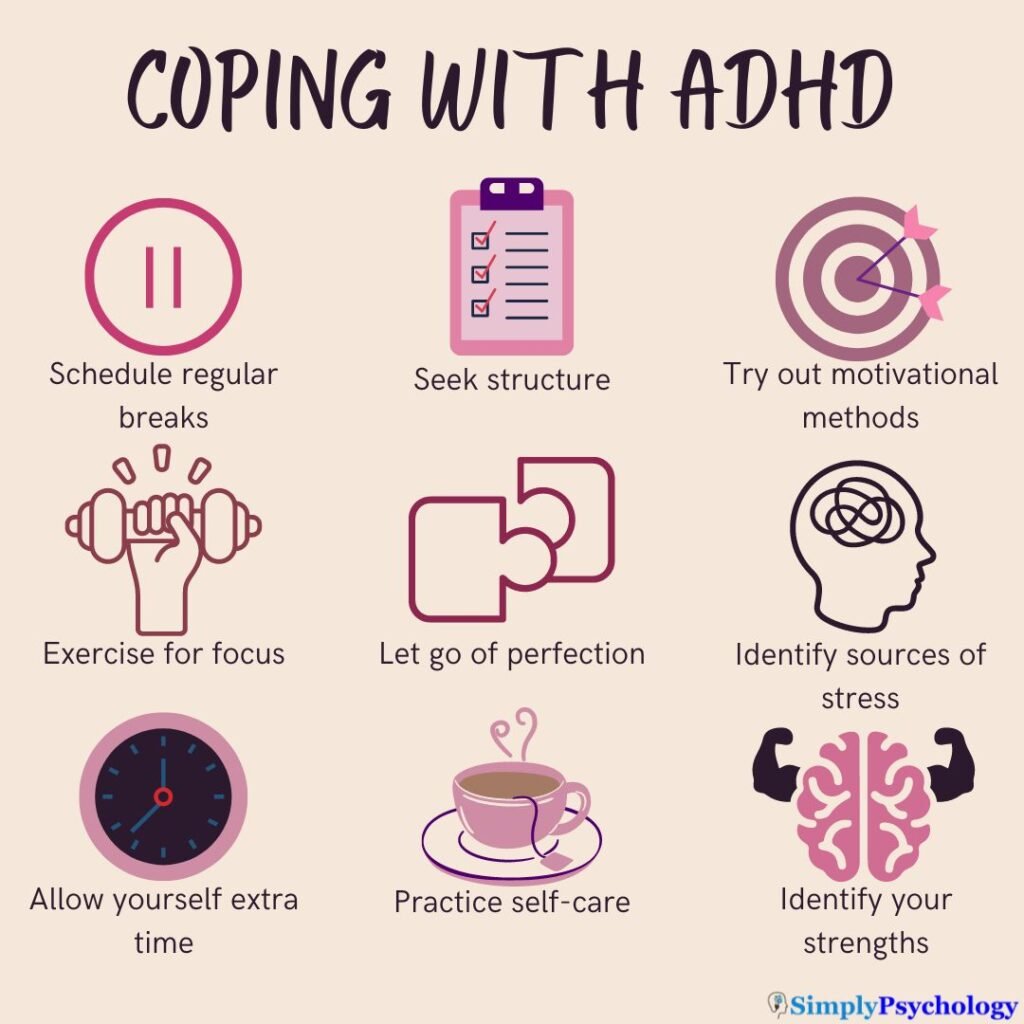On This Page:
Attention-deficit/hyperactivity disorder (ADHD) is a neurodevelopmental condition that affects individuals across various age groups and genders.
However, the impact of ADHD on girls and women often remains underestimated and overlooked.
In a society that traditionally associates ADHD with hyperactive boys, females with this condition frequently go undiagnosed or misdiagnosed, leading to significant challenges and consequences.

ADHD can have a profound impact on most aspects of girls and women’s lives, influencing their academic performance, career prospects, relationships, and overall well-being.
Consequently, girls and women with undiagnosed and unmanaged ADHD face unique hardships, struggling silently and grappling with daily tasks that others may find effortless.
Impact of ADHD
This article aims to shed light on the hidden struggles experienced by girls and women with ADHD, exploring the challenges they face due to underdiagnosis and the lack of appropriate support.
By understanding the complexities of ADHD in females and advocating for improved recognition and tailored interventions, we can work towards empowering these individuals to navigate their lives with greater success, fulfillment, and self-acceptance.
Academic/occupational
The academic functioning of women and girls can be affected by ADHD. The impact is that they may complete tasks later than those without ADHD, and they are more likely to repeat years at school, get suspended, drop out, or have specific learning difficulties.
‘In school I definitely felt that I wasn’t smart enough and that lowered my self-esteem. I was always told that I could do better. No one told me directly that I was stupid, but they asked whether I was working enough, and the comments I got were not positive at all, so I lost self-confidence.’
Debra
The occupational functioning of girls and women can also be affected by ADHD. They may be more likely to have a high turnover of jobs, frequently change the type of work they do, and have lower productivity levels than those without ADHD.
‘I think ADHD for me… really starts to show when adult life takes a hold when you’re going into further qualifications or perhaps you’re going into the working world where you do have to meet certain deadlines, you do have to structure your life… you’re waking up on time, and you’re holding down the other parts of your life.’
Jasmine
Girls and women may have to put in extra work to overcome barriers such as procrastination and attentional difficulties. They may also struggle to manage their time on work tasks:
‘I definitely feel that when my days are busier, I use my time more efficiently, but if there’s more open ended time with just one large task, it can be harder for me to use that time well.’
Christine
While academic and occupational success is indeed possible, girls and women with ADHD may have a feeling of imposter syndrome, feeling as if they do not deserve their success due to how challenging it was to get there, compared to others, who may seem to be succeeding effortlessly.
Home life
Women with ADHD may struggle with maintaining an organized home life. Their finances may be chaotic, paperwork and record-keeping are often poorly managed, and they may feel less able to keep up with the daily tasks of meal planning, cleaning, and other aspects of life management.
‘We’ve (women) been raised to take on a lot of responsibilities and make sure that things are okay . . . and I think that it can be extra challenging for women with ADHD, since women almost are expected to have an inborn ability to organize and maintain things in order.’
Christine
Some women may manage to hide their struggles and may work on tasks late into the night to get things done.
Relationships
Women and girls with ADHD are more likely to have a high turnover of friendships and experience social isolation, peer rejection, and more bullying than those without ADHD.
A study found that girls with childhood ADHD that persisted into adulthood demonstrated social problems (Owens et al., 2017)
They may find that they seek a social network by forming damaging relationships, such as joining a gang or increasing their sexual availability to make relationships; thus, the quality of their relationships may be poorer.
They may also find it difficult to navigate romantic relationships with others, especially if ADHD is undiagnosed and their partner cannot offer understanding.
Even made aware, research suggests that husbands of women with ADHD are less tolerant of their spouse’s ADHD patterns than wives of men with ADHD. As a result, women with ADHD may be more likely to experience breakups or divorce as a consequence of their ADHD.
Mental and physical health
Whether a woman’s life is in chaos or they can hide their struggles, they often describe themselves as feeling overwhelmed and exhausted. Compared to women without ADHD, women with ADHD are more likely to suffer depressive symptoms, are more stressed and anxious, and have lower self-esteem and feelings of shame.

Many clinicians are finding significant concerns and other co-existing conditions in women with ADHD, such as compulsive overeating, alcohol abuse, and chronic sleep deprivation. There is also an alarming link between ADHD and non-suicidal self-injury (NSSI) and suicidal behavior.
For NSSI, it is thought that adolescent externalizing behaviors, poor executive function, and peer victimization are mechanisms for this (Hinshaw et al., 2012). For suicidal behavior, early internalizing problems and peer rejection are documented mediators (Meza, Owens, & Hinshaw, 2021).
Chronic stress can also take its toll on women with ADHD, affecting them physically and psychologically. Chronic stress associated with ADHD puts someone at risk for stress-related diseases such as fibromyalgia.
Therefore, it is becoming clear that the lack of appropriate identification and treatment of ADHD in women is a significant public health concern.
‘there are physical and psychological impacts… particularly for women with ADHD… we see higher rates of self-harm, suicidal intent. We see higher rates of physical challenges like chronic fatigue syndrome, chronic pain, migraines, putting on weight. Some people have learned to use alcohol and cannabis to help calm them to help them with a busy brain.’
Professor Amanda Kirby
Social judgment
Women and girls are often encouraged to exhibit traditional ‘feminine’ qualities such as being empathetic, good with relationships, and nice, as well as traditional ‘masculine’ qualities such as being assertive, academically driven, and career-focused.
So, when they display impulsive, disorganized, or disruptive behaviors, they risk harsh social judgment since these traits violate the norms for stereotypical female behavior.
ADHD also tends to carry a strong social stigma, the negative effects of which add significantly to the impairments caused by the disorder itself. Some variables which can contribute to the stigma include:
- Public’s uncertainty regarding the validity and reliability of the diagnosis.
- Interpretations of impairments as trivial or caused by a lack of willpower or resistance to conform.
- If ADHD is not perceived as a real disorder, a diagnosis of the disorder is less likely to give rise to empathy and understanding.
In an attempt to avoid social judgment, many women and girls with ADHD may spend excessive amounts of energy trying to hide their problems (e.g., through masking), which in turn go unrecognized by others.
Parenting
In a lot of families, the primary parent is the mother. The mothers are usually expected to be the household and family manager, roles that require focus, organization, and planning, as well as the ability to juggle multiple responsibilities.
ADHD typically interferes with these abilities making the job of a mother with ADHD very difficult.
‘When I drop my daughter off at the day care, I’m always late, and I can see what the teachers are thinking. People think you’re a bad mother, right.’
Amber
Women with ADHD are also more likely to have a child with ADHD, which further increases parenting challenges.
Frequently, a woman comes to recognize their own ADHD after one of their children has received a diagnosis. When learning about the child’s diagnosis, the mother may begin to see similar patterns in their own behavior.
Coping with ADHD
The following strategies can be incorporated into life without the guidance of a therapist to reduce the impact of ADHD.

While the following tips can be used by anyone with ADHD, they may be particularly helpful for girls and women, especially if they are struggling to obtain a diagnosis and need to find ways to manage their ADHD on their own.
- Letting go of perfectionism – spending too much time on things that don’t have a big impact on life can create unnecessary stress and anxiety.
- Understanding and accepting the challenges of ADHD instead of putting blame and judgment on yourself.
- Identify any unnecessary sources of stress in daily life and systematically make life changes to lower your stress levels.
- Seek structure and support from family and friends.
- Schedule regular times out, especially when things get overwhelming.
- Develop healthy self-care habits such as getting enough sleep and eating well.
- Get organized where possible, such as writing down the top priorities for the day and creating a schedule.
- Identify your strengths and weaknesses, such as looking at what you know you can do quickest, with little trouble, and what can take the most time.
- Allow yourself extra time to complete tasks if needed.
- Find a motivational method that suits you best – see this article for more information
- Use the Pomodoro technique – a time management system that breaks down the work or study day into chunks, separated by regular short breaks. For instance, you can work on a task solely, without any distractions, for 25 minutes, followed by a 5-minute break. This technique encourages people to work with their time and makes the day more manageable.
- Incorporating physical exercise into a daily routine can not only help people with ADHD feel focused and calm but is also good for coexisting mental health conditions.
Professional Support
It is worth noting that not every person with ADHD needs additional treatment or support and can manage their lives independently. Each person with ADHD is different and so it is down to the individual if they believe they may need extra support from professionals.
Those girls and women fortunate enough to receive an accurate diagnosis of ADHD often face the challenge of finding a professional who can provide appropriate treatment. There are few clinicians experienced in treating adult ADHD, and even fewer are familiar with the unique issues faced by women with ADHD.
Consequently, most clinicians use standard psychotherapeutic methods. Although these can help provide insight into emotional and interpersonal issues, they may not help a woman with ADHD learn to manage her ADHD daily better or learn strategies to lead a productive and enjoyable life.
Effective treatment for women may involve a multimodal approach that includes medication, psychotherapy, stress management, and group therapy.
Medications
ADHD medications come in two types: stimulant and non-stimulant. Stimulants may help people with ADHD focus better by increasing dopamine levels in the brain.
Medications may only be prescribed if a diagnosis of ADHD is obtained.
Common stimulant medications include Ritalin, Adderall, and Vyvanse. However, these medications can have side effects like addiction, sleep problems, or heart problems.
Non-stimulant medications are not as commonly prescribed as stimulant medications and are more often used for those with severe anxiety.
They work differently than stimulants by blocking the reuptake of neurotransmitters like norepinephrine and dopamine, resulting in increased levels in the brain. Popular non-stimulant medications include Wellbutrin (Bupropion) and Strattera (Atomoxetine).
All aspects of a woman’s life need to be considered when prescribing medicative treatment, including the treatment of any coexisting conditions.
Medication may be further complicated by hormone fluctuation across the menstrual cycle and the lifespan (including puberty and menopause), so these factors need to be considered before starting treatment.
Behavior therapy
For some, behavior therapy can help people with ADHD learn the skills required to manage their symptoms and help them complete tasks. Behavior therapy aims to adjust unhelpful behaviors with more helpful ones.
People with ADHD can learn strategies to improve in areas they struggle with, such as organization, focus, and impulse control, among others. Many find that behavior therapy can help them effectively manage their ADHD symptoms without using medications.
Cognitive behavioral therapy
Cognitive behavioral therapy (CBT) involves working with a therapist to identify patterns of behavior and unhelpful thought patterns that can make ADHD symptoms worse.
Once identified, these thoughts and behaviors can be challenged and adjusted to more realistic thinking. New behaviors can be learned to manage stress, obligations, coping, and many aspects of everyday life.
As well as helping with ADHD symptoms, CBT can be helpful for women with ADHD to manage other conditions which can coexist alongside their ADHD, such as depression and anxiety.
Group therapy
As many women with ADHD may feel shame and rejection due to their symptoms, psychotherapy in a group setting designed for women with ADHD may provide a beneficial experience.
This can provide a place where women can feel understood and accepted by other women and provides a safe place to begin their journey towards accepting themselves more and learning to manage their lives better.
Parent management programs
Evidence-based parent management programs are found to be effective in children with ADHD and are also recommended for parents with ADHD.
However, these approaches have shown that parent training may be less effective if the mother has ADHD signs that are particularly debilitating.
Therefore, it may be useful to incorporate adult ADHD life management strategies into parent training programs for mothers with ADHD.
Frequently Asked Questions
Can early intervention and diagnosis improve outcomes for girls and women with ADHD?
Yes, early intervention and diagnosis can significantly improve outcomes for girls and women with ADHD.
By identifying and addressing ADHD symptoms early on, appropriate support and interventions can be implemented to enhance academic performance, social functioning, and overall quality of life.
Early intervention allows for the development of coping strategies, improved self-awareness, and access to specialized resources.
It also helps prevent potential negative consequences associated with untreated ADHD, such as low self-esteem, academic difficulties, and mental health challenges, leading to better long-term outcomes and a higher likelihood of successfully managing ADHD symptoms.
What steps can individuals take to advocate for greater awareness and understanding of ADHD in girls and women?
To advocate for greater awareness and understanding of ADHD in girls and women, individuals can take several steps.
They can share personal experiences and stories to raise awareness, engage in open conversations about ADHD, and educate others about the unique challenges faced by girls and women with ADHD.
Supporting and promoting ADHD organizations, participating in ADHD-related events, and sharing informative resources on social media platforms can also contribute to increased awareness.
Additionally, encouraging research, lobbying for policy changes, and promoting inclusive educational environments can help create a more supportive and understanding society for individuals with ADHD.
How can educators and healthcare professionals better support girls and women with ADHD in various settings?
Educators and healthcare professionals can better support girls and women with ADHD by adopting a multi-faceted approach.
This includes increasing awareness and knowledge about the unique challenges faced by females with ADHD, promoting early identification and diagnosis, and implementing tailored interventions and accommodations in educational settings.
Providing clear communication, offering individualized learning strategies, fostering a supportive and inclusive environment, and collaborating with parents, caregivers, and mental health professionals are crucial.
Regular monitoring of progress, providing feedback, and offering targeted support services can further enhance the educational experience and overall well-being of girls and women with ADHD.
References
Advokat, C. D., & Scheithauer, M. (2013). Attention-deficit hyperactivity disorder (ADHD) stimulant medications as cognitive enhancers. Frontiers in neuroscience, 7, 82.
Children and Adults with Attention-Deficit/Hyperactivity Disorder. (n.d.). Women and Girls. Retrieved 2022, January 25, from: https://chadd.org/for-adults/women-and-girls/
Chronis‐Tuscano, A. (2022). ADHD in girls and women: a call to action–reflections on Hinshaw et al.(2021). Journal of Child Psychology and Psychiatry.
Finlay, M. (2022, May 12). Why aren’t women getting diagnosed with ADHD? [Audio podcast episode]. In Science Weekly.
Gershon, J., & Gershon, J. (2002). A meta-analytic review of gender differences in ADHD. Journal of attention disorders, 5 (3), 143-154.
Gurian, A. (2014). Girls with ADHD: overlooked, underdiagnosed, and underserved. NYU Child Study Center About Our Kids .
Hinshaw, S. P. (2002). Preadolescent girls with attention-deficit/hyperactivity disorder: I. Background characteristics, comorbidity, cognitive and social functioning, and parenting practices. Journal of consulting and clinical psychology, 70 (5), 1086.
Hinshaw, S. P., Nguyen, P. T., O’Grady, S. M., & Rosenthal, E. A. (2021). Annual Research Review: Attention‐deficit/hyperactivity disorder in girls and women: underrepresentation, longitudinal processes, and key directions. Journal of Child Psychology and Psychiatry.
Hinshaw, S. P., Owens, E. B., Zalecki, C., Huggins, S. P., Montenegro-Nevado, A. J., Schrodek, E., & Swanson, E. N. (2012). Prospective follow-up of girls with attention-deficit/hyperactivity disorder into early adulthood: continuing impairment includes elevated risk for suicide attempts and self-injury. Journal of consulting and clinical psychology, 80 (6), 1041.
Holthe, M. E. G., & Langvik, E. (2017). The strives, struggles, and successes of women diagnosed with ADHD as adults. Sage Open, 7(1), 2158244017701799.
Meza, J. I., Owens, E. B., & Hinshaw, S. P. (2021). Childhood predictors and moderators of lifetime risk of self-harm in girls with and without attention-deficit/hyperactivity disorder. Development and psychopathology, 33 (4), 1351-1367.
Öster, C., Ramklint, M., Meyer, J., & Isaksson, J. (2020). How do adolescents with ADHD perceive and experience stress? An interview study. Nordic Journal of Psychiatry, 74(2), 123-130.
Owens, E. B., Zalecki, C., Gillette, P., & Hinshaw, S. P. (2017). Girls with childhood ADHD as adults: Cross-domain outcomes by diagnostic persistence. Journal of Consulting and Clinical Psychology, 85(7), 723–736.
Quinn, P. O., & Madhoo, M. (2014). A review of attention-deficit/hyperactivity disorder in women and girls: uncovering this hidden diagnosis. The primary care companion for CNS disorders, 16 (3).
Steer, J. (Host). (2022, December 21). ADHD in women, Prof Lucy Easthope, Debbie [Audio podcast episode]. In Women’s Hour.

